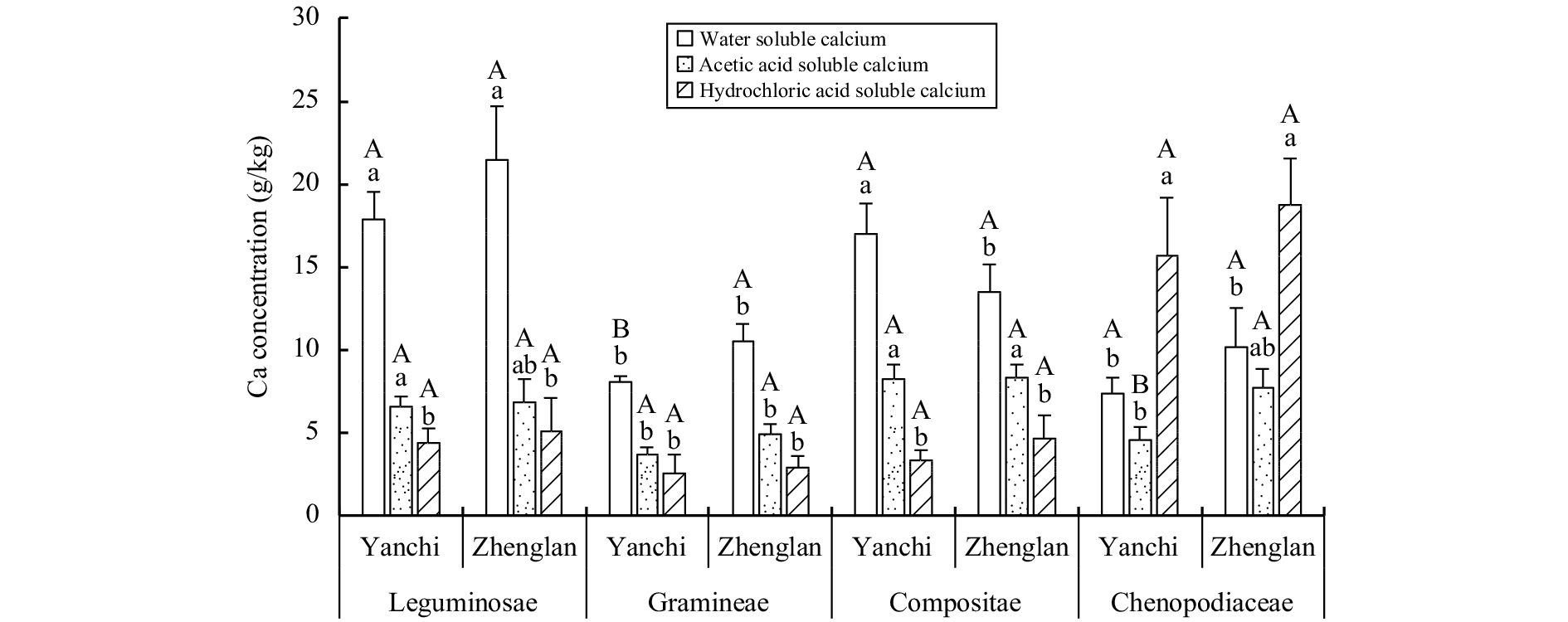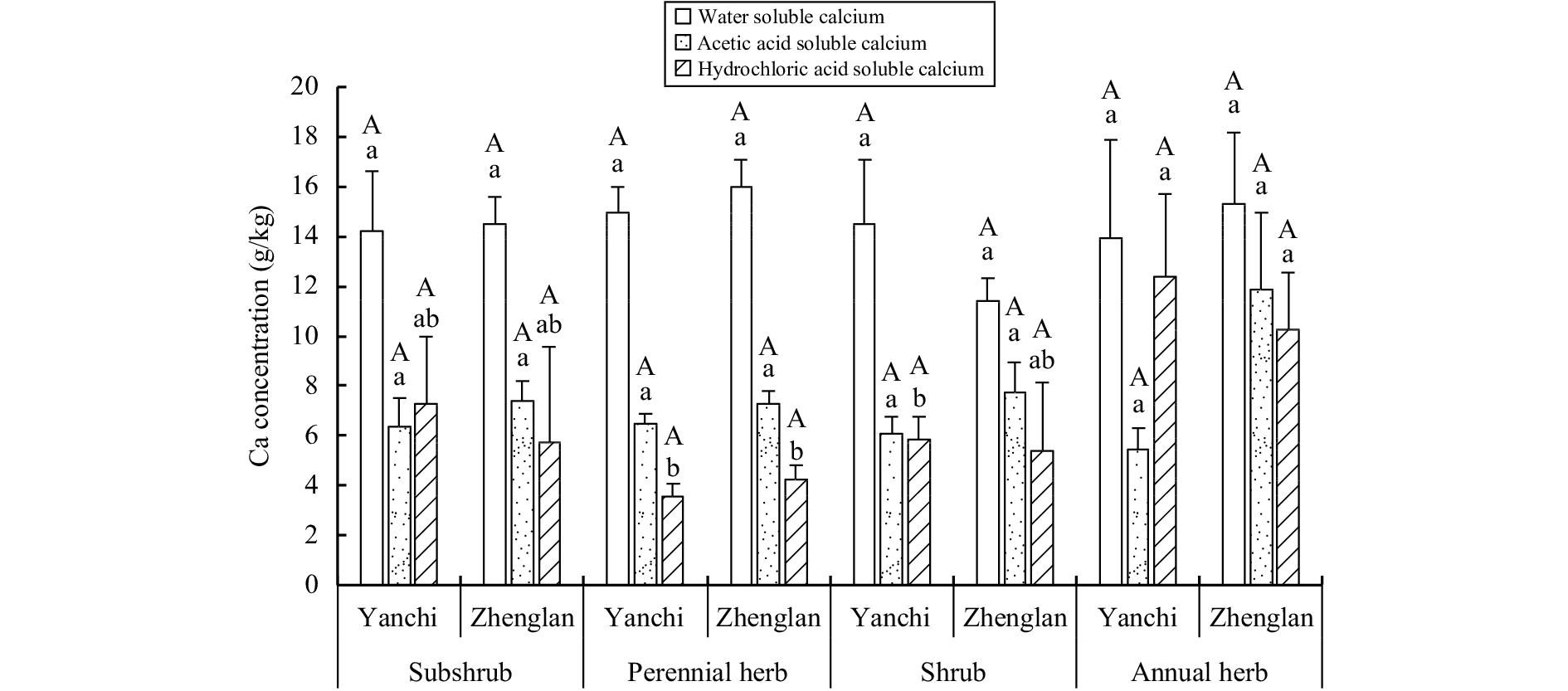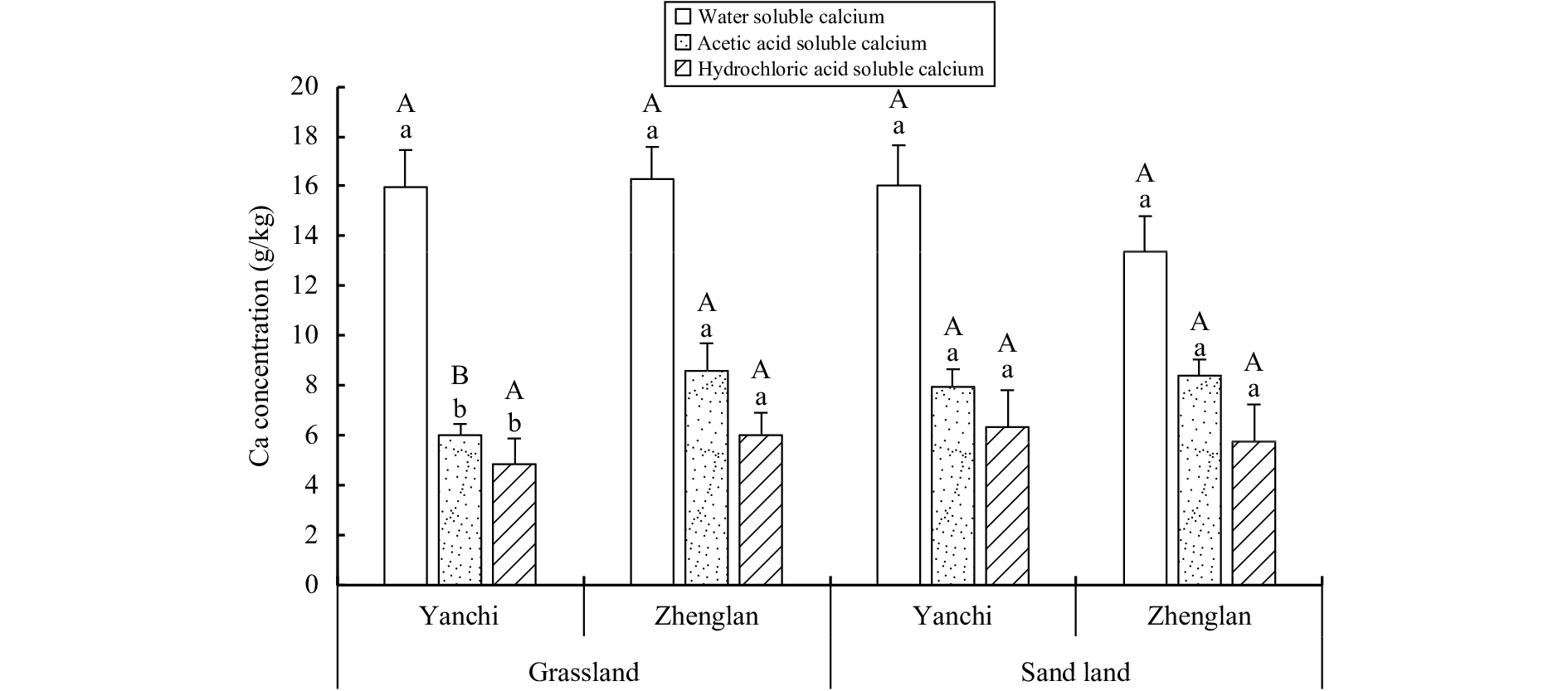Sciences in Cold and Arid Regions ›› 2018, Vol. 10 ›› Issue (4): 340–346.doi: 10.3724/SP.J.1226.2018.00340
Comparisons of plant calcium fraction between two different vegetation zones in semi-arid region
MengQi Li,XingDong He*( ),XiangXiang Yang,YueDan Zhao,YuBao Gao
),XiangXiang Yang,YueDan Zhao,YuBao Gao
- College of Life Sciences, Nankai University, Tianjin 300071, China
| 1 |
Bradfield EG Extraction of calcium fractions from plant material. Communications in Soil Science and Plant Analysis 1977; 8: 7 563- 572.
doi: 10.1080/00103627709366747 |
| 2 | Ci HC, He XD, Li R, et al. Characteristics of plant calcium fractions for 25 species in Tengger Desert. Sciences in Cold and Arid Regions 2010; 2: 2 168- 174. |
| 3 |
Clark CJ, Smith GS, Walker GD The form, distribution and seasonal accumulation of calcium in kiwifruit leaves. New Phytologist 1987; 105: 3 477- 486.
doi: 10.1111/j.1469-8137.1987.tb00885.x |
| 4 |
Edel KH, Marchadier E, Brownlee C, et al. The evolution of calcium-based signalling in plants. Current Biology 2017; 27: 13 R667- R679.
doi: 10.1016/j.cub.2017.05.020 |
| 5 | He XD, You WX, Yu D, 2016. Ecological Restoration Theory and Vegetation Reconstruction Technique in Yanchi County of the Ningxia Hui Autonomous Region. Tianjin: Nankai University Press |
| 6 | Himelrick DG, Walker CE Seasonal trends of calcium, magnesium and potassium fractions in apple leaf and fruit tissues. Journal of the American Society of Horticulture Science 1982; 107: 1078- 1080. |
| 7 |
Hirschi KD The calcium conundrum. Both versatile nutrient and specific signal. Plant Physiology 2004; 136: 1 2438- 2442.
doi: 10.1104/pp.104.046490 |
| 8 |
Islam MN, Kawasaki M Evaluation of calcium regulating roles of guttation and calcium oxalate crystals in leaf blades and petioles of hydroponically grown Eddo. Plant Production Science 2015; 18: 1 11- 21.
doi: 10.1626/pps.18.11 |
| 9 |
Jian LC, Wang H Ca2+ signaling in plant cell response and adaptation to low temperature, drought and salt stresses . Chinese Bulletin of Botany 2008; 25: 3 255- 267.
doi: 10.3969/j.issn.1674-3466.2008.03.001 |
| 10 |
Jiang TH, Zhan XH, Xu YC, et al. Roles of calcium in stress-tolerance of plants and its ecological significance. Chinese Journal of Applied Ecology 2005; 16: 5 971- 976.
doi: 10.13287/j.1001-9332.2005.0079 |
| 11 |
Li XL, Zhang WJ, Lu JW, et al. Calcium oxalate biomineralization in plants. Chinese Science Bulletin 2012; 57: 26 2443- 2455.
doi: 10.1360/csb2012-57-26-2443 |
| 12 |
Li XX, Zhang DZ, Lynch-Holm VJ, et al. Isolation of a crystal matrix protein associated with calcium oxalate precipitation in vacuoles of specialized cells. Plant Physiology 2003; 133: 2 549- 559.
doi: 10.1104/pp.103.023556 |
| 13 |
Li YQ, Zhang JP, Zhao XY, et al. Comparison of soil physico-chemical properties under different land-use and cover types in northeastern China's Horqin Sandy Land. Sciences in Cold and Arid Regions 2016; 8: 6 495- 506.
doi: 10.3724/SP.J.1226.2016.00495 |
| 14 | Liang S, Wang GY Research advance on the salt-resistant structures of halophytes. Journal of Changchun Normal University 2015; 34: 10 71- 74. |
| 15 |
Liu ZH, Xu JH, Li WH Complex network analysis of climate change in the Tarim River Basin, Northwest China. Sciences in Cold and Arid Regions 2017; 9: 5 476- 487.
doi: 10.3724/SP.J.1226.2017.00476 |
| 16 |
Luo YQ, Zhao XY, Ding JP, et al. Vertical distribution of Artemisia halodendron root system in relation to soil properties in Horqin Sandy Land, NE China . Sciences in Cold and Arid Regions 2016; 8: 5 411- 418.
doi: 10.3724/SP.J.1226.2016.00411 |
| 17 |
Ma H, Wang S, Zhou YL Research progress of calcium-dependent protein kinases in plants. Journal of Nanjing Agricultural University 2017; 40: 4 565- 572.
doi: 10.7685/janu.201701036 |
| 18 | Marschner H Calcium nutrition of higher plants. Netherlands Journal of Agricultural Science 1974; 22: 275- 282. |
| 19 | Marschner H, 1995. Mineral Nutrition of Higher Plants. The 2nd Ed.. London: Academic Press |
| 20 |
Mazen AMA Calcium oxalate deposits in leaves of Corchorus olitorius as related to accumulation of toxic metals . Russian Journal of Plant Physiology 2004; 51: 2 281- 285.
doi: 10.1023/B:RUPP.0000019226.03536.21 |
| 21 |
Prasad R, Shivay YS Oxalic acid/oxalates in plants: from self-defence to phytoremediation. Current Science 2017; 112: 8 1665- 1667.
doi: 10.18520/cs%2Fv112%2Fi08%2F1665-1667 |
| 22 |
Shao HB, Song WY, Chu LY Advances of calcium signals involved in plant anti-drought. Comptes Rendus Biologies 2008; 331: 8 587- 596.
doi: 10.1016/j.crvi.2008.03.012 |
| 23 |
Tan LY, Ma HN Advance in the research of plant in response to calcium ions stress. Plant Physiology Journal 2017; 53: 7 1150- 1158.
doi: 10.13592/j.cnki.ppj.2017.0036 |
| 24 |
Tooulakou G, Giannopoulos A, Nikolopoulos D, et al. Reevaluation of the plant "gemstones": calcium oxalate crystals sustain photosynthesis under drought conditions. Plant Signaling & Behavior 2016; 11: 9 e1215793.
doi: 10.1080/15592324.2016.1215793 |
| 25 |
Volk GM, Lynch-Holm VJ, Kostman TA, et al. The role of druse and raphide calcium oxalate crystals in tissue calcium regulation in Pistia stratiotes Leaves . Plant Biology 2002; 4: 1 34- 45.
doi: 10.1055/s-2002-20434 |
| 26 |
Wang F, Li ZL, Chen YL, et al. Recent advances on inhibition mechanisms of calcium on plant diseases. Biotechnology Bulletin 2017; 33: 2 1- 7.
doi: 10.13560/j.cnki.biotech.bull.1985.2017.02.001 |
| 27 |
Xu JJ, Ci HC, He XD, et al. Features of calcium crystals and calcium components in 54 plant species in salinized habitats of Tianjin. Chinese Journal of Applied Ecology 2012; 23: 5 1247- 1253.
doi: 10.13287/j.1001-9332.2012.0198 |
| 28 |
Xue PP, Gao YB, He XD An analysis of calcium components of Artemisia ordosica plant on sandy lands in different ecological regions . Acta Ecologica Sinica 2013; 33: 5 1475- 1481.
doi: 10.5846/stxb201207261065 |
| 29 |
Yan QD, Su PX, Chen HB, et al. Comparative studies on crystal idioblasts of five desert C4 plants . Journal of Plant Ecology (Chinese Version) 2008; 32: 4 873- 882.
doi: 10.3773/j.issn.1005-264x.2008.04.016 |
| 30 | You WX, He XD, Zhang WJ, et al., 2016. Comprehensive Scientific Survey of Ningxia Habahu National Nature Reserve. Tianjin: Nankai University Press |
| 31 |
Yu TF, Feng Q, Si JH, et al. Evapotranspiration of a Populus euphratica Oliv. forest and its controlling factors in the lower Heihe River Basin, Northwest China . Sciences in Cold and Arid Regions 2017; 9: 2 175- 182.
doi: 10.3724/SP.J.1226.2017.00175 |
| 32 |
Zhang HC, Yin WL, Xia XL The mechanism of Ca2+ signal transduction under abiotic stresses in plants . Chinese Bulletin of Botany 2007; 24: 1 114- 122.
doi: 10.3969/j.issn.1674-3466.2007.01.011 |
| 33 |
Zhang K, Tian CY, Li CJ Review of progress of studies on salt-tolerance mechanisms of annual halophytes. Chinese Journal of Plant Ecology 2009; 33: 6 1220- 1231.
doi: 10.3773/j.issn.1005-264x.2009.06.023 |
| 34 | Zhang Y, Liu JK, Fang JH, et al. Deformation properties of chloride saline soil under action of a low-temperature environment and different loads. Sciences in Cold and Arid Regions 2017; 9: 3 307- 311. |
| 35 |
Zhao LL, Wang PC, Chen C, et al. Effects of exogenous Ca2+ on the growth, physiological characters of Sophora viciifolia seedlings in Karst Mountain Area under the drought stress . Journal of Nuclear Agricultural Sciences 2017; 31: 10 2039- 2046.
doi: 10.11869/j.issn.100-8551.2017.10.2039 |
| 36 |
Zheng Y, Chen ZJ Organellar calcium signaling in plants. Plant Physiology Journal 2015; 51: 8 1195- 1203.
doi: 10.13592/j.cnki.ppj.2015.0119 |
| 37 |
Zhou W, Wang H The physiological and molecular mechanisms of calcium uptake, transport, and metabolism in plants. Chinese Bulletin of Botany 2007; 24: 6 762- 778.
doi: 10.3969/j.issn.1674-3466.2007.06.007 |
| 38 |
Zhu GL, Ma Y, Han L, et al. Current status of research on morphological structure, biological function and formation mechanism of plant crystals. Acta Ecologica Sinica 2014; 34: 22 6429- 6439.
doi: 10.5846/stxb201302240293 |
| No related articles found! |






